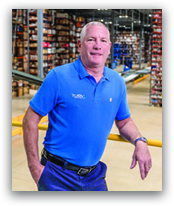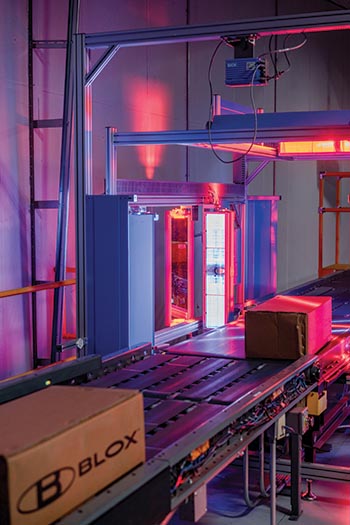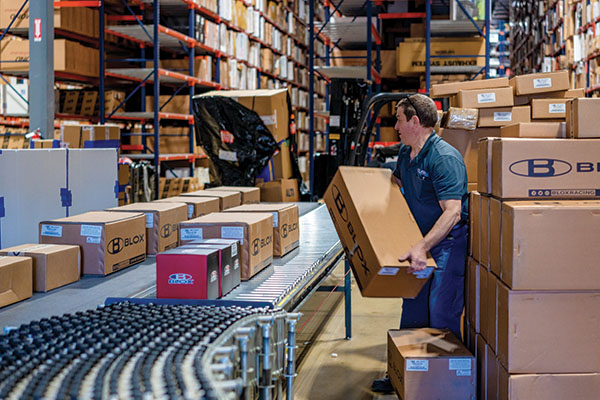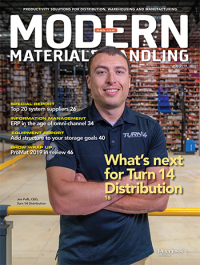System Report: What’s next for Turn 14 Distribution
A Pennsylvania-based distributor of performance auto parts moved from conventional to automated processes and expanded its network from one to three DCs. The result: improved accuracy, throughput and industry-leading customer service.
What’s next? That’s a question often asked by fast-growing companies. In an order fulfillment environment where companies put a premium on price, selection and customer service, companies not only find themselves running out of space and bumping up against inefficient processes, but also having to re-think their entire distribution strategy to take business to the next level of performance.
See inside the Turn 14 Distribution Center in our in depth look at the equipment in place.
That was the situation facing Turn 14 Distribution, a Horsham, Pa.,-based distributor of performance auto parts. In 2013, the then 11-year-old company was operating from a single, space-constrained 52,000-square-foot facility. To meet the distributor’s goals for growth and nationwide two-day delivery, Turn 14 realized it would not only have to rethink its processes, it would have to design an entirely new network. What’s next was to conduct a network design study, which identified three strategic locations to meet customer service requirements; and, then, working with a systems integrator (Honeywell Intelligrated) to develop a new warehouse design. The design brought in a custom-built warehouse management system (WMS), bar code scanning, weight and dimension capture, a light-directed putwall, and conveyor and sortation. With those two steps complete, Turn 14 Distribution built and went live with three new distribution centers, back-to-back, in Pennsylvania, Nevada and Texas, increasing its available space to 710,000 square feet in just a few years.
The result: While still a small- to mid-sized distributor, Turn 14 Distribution can now provide customer service levels on behalf of its manufacturing partners on the same terms as much larger distributors in other industries, including visibility into its inventory; two-day service across the country plus one-day service to many locales; and free returns.
Automation, in turn, has improved accuracy, increased throughput and allows for late-in-the-day order cutoff times. “We brought a new level of technology and service to an industry that was accustomed to two-week delivery times when we first started,” says Jon Pulli, CEO and co-founder of the company. “It also solidified us as a leader in our space. When you start from scratch, you have the advantage of putting together a network that meets the needs of today’s day and age.”
 “We have significantly increased the accuracy of all of our processes, from receiving through shipping,” adds Jim Larkin, director of building operations. “Because we capture so much information at receiving, including weight and dimension information, we know exactly what we have. Our inventory stays up to date with regular cycle counting. And the automation allows us to do a larger percentage of our business later in the day, with room to grow across the network exponentially.”
“We have significantly increased the accuracy of all of our processes, from receiving through shipping,” adds Jim Larkin, director of building operations. “Because we capture so much information at receiving, including weight and dimension information, we know exactly what we have. Our inventory stays up to date with regular cycle counting. And the automation allows us to do a larger percentage of our business later in the day, with room to grow across the network exponentially.”
Turn 14 Distribution’s achievements have not gone unnoticed: In 2016 and 2018, the company was recognized by the Specialty Equipment Market Association (SEMA) as the Wholesale Distributor of the Year, and Pulli was awarded Innovator of the Year.
High performance growth
Turn 14 Distribution describes itself as a performance distributor “catering to niche vehicle markets, along with stocking its partner manufacturers’ full product lines for quick order fulfillment.” A typical customer is a speed shop with a sales counter or an e-commerce retailer. “If you just want to replace your parts with aftermarket auto parts, that’s not for us,” Pulli says. “Our customer is the person trying to improve the performance of the vehicle.”
Its go-to-market strategy includes sales specialists with deep industry experience in their particular markets and access to a massive amount of inventory: The company stocks 75,000 SKUs, but tracks 365,000 SKUs in its system and has access to 1 million SKUs through its manufacturing partners, according to Pulli. Customer service, enabled by the distribution network and investments in technology, is the third leg of the strategy stool. The company boasts that it can offer one-day shipping to 43% of the domestic U.S. population, 100% of the population in two days and offers competitive freight rates for global shipments. It promises flat-rate shipping to its customers’ shops, late shipping cutoff times, six-day-a-week operations and same-day, in-stock order fulfillment.
Turn 14 Distribution was founded in 2002 by Pulli and his partner, chief technology officer Chris Candido. They took the name from Road America, a 4.0841-mile-long race track in Elkhart Lake, Wisc., that has been described by racing journalists as “the best test of road racing in North America.” Considered one of the most challenging road courses in the country, the 14th and final turn is a true test of driving skill. Pulli says he was an entrepreneur at heart after growing up in an entrepreneurial family. He and Candido were also car enthusiasts, as are many of the company’s employees: “We were an e-commerce retailer that turned into a wholesale distributor because no one could service us,” says Pulli. They began as an e-commerce enterprise, buying from distributors who weren’t set up to deal with e-commerce.
The first facility in Pennsylvania was a 4,000-square-foot space with a retail counter for walk in sales plus some wholesale business to shops that found the Website online. In 2007, with the wholesale business growing, Pulli and Candido made the leap to a 100% wholesale business. “We were about 50/50 wholesale and retail, but saw that our future was wholesale,” Pulli says. “We sold the retail business to one of our employees and concentrated on wholesale so we were aligned with our manufacturing partners and not trying to compete with our retail customers.” Operations were moved to a 17,000-square-foot facility, with wide aisles, 18-foot pallet racks, one orderpicker and no lift truck. It outgrew that space by 2010.
 That was followed by a 52,000-square-foot facility in Pennsylvania with narrow aisle storage for better space utilization. But, by 2013, Pulli and Candido realized that if they were going to keep growing they needed more space and more locations. “We knew that we wanted to be a large company,” says Pulli. “And, we knew that we wanted to create a distribution engine for the manufacturers who do $5 to $50 million worth of business and will never be able to build their own network with multiple DCs.”
That was followed by a 52,000-square-foot facility in Pennsylvania with narrow aisle storage for better space utilization. But, by 2013, Pulli and Candido realized that if they were going to keep growing they needed more space and more locations. “We knew that we wanted to be a large company,” says Pulli. “And, we knew that we wanted to create a distribution engine for the manufacturers who do $5 to $50 million worth of business and will never be able to build their own network with multiple DCs.”
He adds: “We didn’t invest to support; we invested to create.” The executive team began asking what was next beyond a single 52,000-square-foot facility.
The do-it-yourself network
First, they implemented an interim solution in a 50,000-square-foot distribution center in Reno, Nev., using processes similar to the Pennsylvania DC. But that was more a stop-gap measure as Turn 14 Distribution began to define what a next generation network would look like. Initially, Pulli says the company met with consultants and even hired an auditing firm for the network design. In the end, the company decided to do the analysis on its own. “We couldn’t find anyone who approached network design in a holistic manner,” he says. “If you end up in the wrong municipality, for instance, it might be a strategic location but you pay a gross receipts tax. We gave data requests to carriers and plugged in that logistics information, then we looked at labor availability and quirks that might not be obvious, like local taxes.”
The result was a three-location network: a 275,000-square-foot facility in Arlington, Texas; 180,000-square-feet in Reno, Nev.; and 240,000-square-feet in Horsham, Pa. “Our goal was to get to the smallest footprint that would accommodate a very high SKU count and that’s what we ended up with,” says Larkin. What’s more, they were built sequentially, one right after the other. “If I had it to do over, I’d do it the same way because with each facility, we got better,” says Pulli. While the facilities vary in terms of size, they are essentially cookie-cutter when it comes to operations.
With a network strategy in place by 2014, Turn 14 Distribution realized it had to re-think how it stored and picked product. At the time, some limited automation was installed in the facilities, but associates received and picked from paper and keyed in information to print out shipping labels. It was slow, labor intensive and error-prone. “We knew we had to address our bottlenecks,” says Larkin.
Custom Technology
With a founding partner who serves as the chief technology officer, it comes as no surprise that Turn 14 Distribution has put an emphasis on the use of technology to improve its operations. Much of that has been developed in house. “We have a team of developers on staff, and they developed our WMS, EDI, API, accounting integration, and Website integration,” says Pulli.
Task interleaving is one of the major features of the warehouse management system (WMS). An associate completing a putaway assignment, for instance, may next be directed to do cycle counting or to begin picking to their cart, dropping items at one of several induction locations along the conveyor system before returning to a pickup location to get more items for putaway.
Inventory visibility is also an important feature. Turn 14 Distribution has built a Web portal that allows dealers to see inventory in stock at its facilities and at its manufacturing partners. Other systems analyze the performance of suppliers to provide more accurate delivery times. Why go it alone? “We developed new capabilities ourselves because we couldn’t wait for someone to do it for us,” says Pulli.
The distribution team investigated implementing some type of automated storage and goods-to-person picking, but determined that it was too expensive for their operation. Instead, they chose a hybrid approach. “Our goal was automated sortation, to become paperless on both ends of the operation and to achieve the highest accuracy rate possible,” Larkin says.
To make that happen, Turn 14 Distribution worked closely with the systems integrator’s design team. The final design includes an emphasis on labeling and data capture, including weight and dimension information, when products are received. That ensures accuracy on the front end that will pay dividends later in the process. Associates have the ability to send a photo of an item they can’t identify to the procurement team that ordered it to ensure it’s labeled properly. That upfront effort reduces errors later, makes for more efficient storage and makes possible automatic box selection and consolidation during picking and packing.
Putaway is optimized in a couple of ways. The facility features several storage areas that can accommodate the variety of part sizes. For instance, one area for small parts, another for medium-sized parts and another for large parts from 36 to 80 inches long. Conveyor and sortation systems have been modified to handle the variation in part sizes as well, using wider radius turns to handle oversized parts. The system uses random putaway, rather than grouping parts by manufacturer as they used to do, to better use space. In addition, parts are located in a storage zone according to their velocity, with the fastest-moving parts stored for easy accessibility. Single line orders go to a packing station set up to quickly get them labeled and out the door while multi-line orders are sent to a 40-foot-long putwall, where they are consolidated and sent on to shipping.
Pulli and Larkin note a learning curve—and an initial 50% turnover in staff—did emerge as associates transitioned from manual processes they were familiar with to working with automation. A little more than two years after putting it all in place, they are reaping the rewards of increased capacity, growth and velocity. “We invested in distribution and logistics as a go-to-market strategy, and it has established us as a leader,” says Pulli.
The only question left is: Now, what’s next?

Article Topics
Automation News & Resources
Walmart chooses Swisslog AS/RS and software for third milk processing facility Lucas Watson appointed CSO for Körber’s Parcel Logistics business in North America 60 Seconds with Bob Trebilcock, outgoing executive editor, Modern Materials Handling Kathleen Phelps to join FORTNA as chief financial officer Coles automates grocery distribution in Australia 2024 Intralogistics Robotics Survey: Robot demand surges Warehouse automation extends life of cheese DC by a decade More AutomationLatest in Materials Handling
The (Not So) Secret Weapons: How Key Cabinets and Asset Management Lockers Are Changing Supply Chain Operations MODEX C-Suite Interview with Harold Vanasse: The perfect blend of automation and sustainability Consultant and industry leader John M. Hill passes on at age 86 Registration open for Pack Expo International 2024 Walmart chooses Swisslog AS/RS and software for third milk processing facility NetLogistik partners with Vuzix subsidiary Moviynt to offer mobility solutions for warehouses Materials Handling Robotics: The new world of heterogeneous robotic integration More Materials HandlingAbout the Author
Subscribe to Materials Handling Magazine

Find out what the world's most innovative companies are doing to improve productivity in their plants and distribution centers.
Start your FREE subscription today.
April 2024 Modern Materials Handling

Latest Resources












